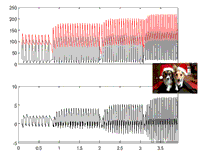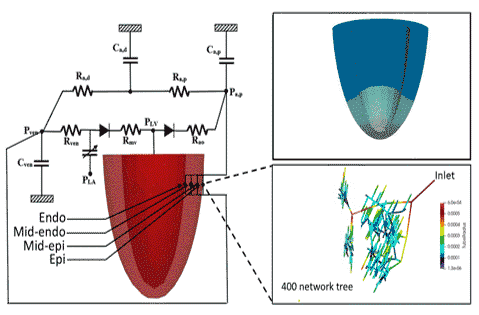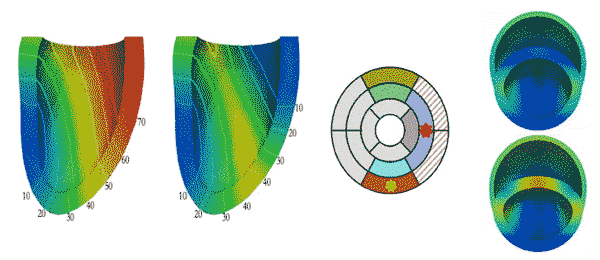Contact Us!
For more information on the Fan Flow Integrated Research Laboratory, contact Dr. Lei Fan.
Report a Problem
To report a problem with this website, contact BME Communications, or report an accessibility issue.
Cardiac demand-supply is the relationship between the amount of oxygen heart tissues require and the amount of oxygen those tissue are receiving. Under normal, healthy, resting conditions, the tissues of the heart are well supplied, taking up 70% of the oxygen provided by normal blood flow. Under stress conditions, as may be seen with exercise, a number of mechanisms work together to increase oxygen delivery to the tissues of the heart, thus facilitating increased heart rate and blood supply to the rest of the body. In a case of demand-supply mismatch, the tissues of the heart receive insufficient oxygen, which can result in tissue damage and death.
Because the mechanisms affording normative demand-supply are so complex, and because quantification of demand can only be made theoretically in living organisms, a modeling framework will prove invaluable in conquering limitations inherent in pure experimental and clinical studies. It will also elucidate the effects of left ventricular geometry and left ventricular mechanics on demand-supply mismatch transmurally and lend understanding to the mechanisms of some clinical observations.
For this reason, researchers in the F2IRL seek to develop computational modeling frameworks that couple systemic circulation of left ventricular and coronary perfusion with flow regulation mechanisms to investigate myocardial demand-supply under graded exercise conditions. Investigations will elucide the demand-supply of transmural locations across the heart wall both for healthy patients and those with cardiac diseases. Results can be used to help improve therapies for individuals with cardiac disease and dysfunction, as well as help predict impending dysfunction, such as ischemia and cardiac arrest.
To create a computational modeling framework for systemic circulation of left ventricular and coronary perfusion, the F2IRL will elucidate mechanisms, predict the effects of each factor, and work to optimize therapies.
 Elucidate Mechanisms
Elucidate MechanismsTo elucide mechanisms, pressure (top right) and flow (bottom right) metrics will be captured under normal and stressed conditions. It is expected that Myocardial work and PVA will effect flow regulation and vasodilator signal, which will effect myocardial contractility.
The effects of various factors will be determined by use of intramural ventricular schematic (left) creating ventricular displacement on perfusion (right top) and ventricular vessel tree (right bottom).


In addition, data will be used to determine flow regulation, which is determined by flow rate in ml/min as a function of perfusion pressure (top), as well as demand-supply ratio as a function of radial position (not pictured).
The optimization of therapy may include the use of activation models (left), ventricular ischemia plotting for lead optimization (center), and ventricular displacement mapping (right).

Whether seasoned researcher, advanced student or curious undergrad, the Fan Flow Integrated Research Laboratory has opportunities for innovators of all types. For further information on current opportunities to get involved with the F2IRL, contact Principal Investigator Dr. Lei Fan.